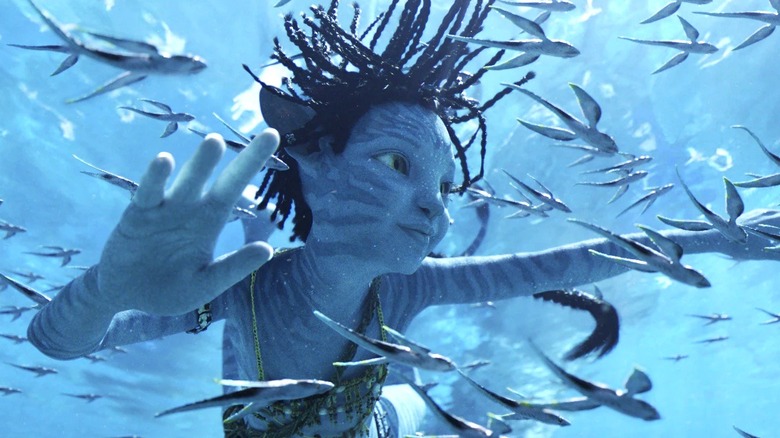The Avatar Faithful Are Split On The Way Of Water's Use Of High Frame Rate Scenes
Meeting the high expectations for the visuals for "Avatar: The Way of Water" was always going to be a tall task. Following James Cameron's groundbreaking 2009 film, the sequel had to not only continue and build off of the grand world of Pandor created by Cameron in the first "Avatar," but it also had up the ante of its visual effects. The first film was already considered a major game changer, but a lot of time has passed since the first release, and viewers expected Cameron to use new technology to break ground yet again.
Now, 13 years and over hundreds of millions of dollars later, the long-awaited sequel is here for all to see — and what a sight it is. While the film's narrative hasn't been considered anything spectacular (via Rotten Tomatoes), its eye-popping visual effects have been the subject of widespread acclaim, with Variety film critic Owen Gleiberman saying, "Cameron has raised not only the stakes of his effects artistry but the choreographic flow of his staging, to the point of making 'The Way of Water,' like 'Avatar,' into the apotheosis of a must-see movie."
For as much acclaim as the rich details, sweeping vistas, and dazzling textures have received, one aspect of the film's visuals has received a more mixed reaction — the frame rate. James Cameron's experiment with the technology has yielded some especially passionate fan responses.
The change between frame rates turned some heads
For "Avatar: The Way of Water," Cameron chose to go between the traditional 24 and the faster 48 frames per second (via Variety), with many fans noting the switch up on multiple occasions. On a Reddit thread discussing spoilers for the film, Redditor u/DrBillyHarford asked, "Was I the only one who liked the HFR [high frame rate]? I thought it made the movie look even better!" u/kvothe5688 concurred with the stated question, writing, "I agree. underwater scenes were amazing. I could watch Kiri [Sigourney Weaver] interacting with nature for six more hours."
For others, though, the constant switching between the frame rates seemed to be the biggest complaint. Redditor u/GregTheTimeless is one of these fans, writing, "The scenes with it looked really cool, but when it changed back to 24, it looked really laggy in the theatre I was in." Others weren't so kind, such as u/nexxai who admitted, "I was expecting to hate the HFR, but I actually ended up enjoying it, and then hated how they kept bouncing back and forth between the 24 and 48 fps. I noticed it every time and it momentarily took me out of the immersiveness." Redditor u/RedditorNumber679260 was especially unapologetic, saying that the film, "LOOKED LIKE A VIDEO GAME sequence. Awesome for a second, then stupid. WE WALKED OUT. 35 min." Whether it worked or not for some viewers, Cameron's approach to the technique was certainly labored over.
Cameron hoped to solve the biggest issue plaguing high frame rate movies
"Avatar: The Way of Water" is not the first film to experiment with a higher frame rate. Past films such as Peter Jackson's "Hobbit" trilogy and Ang Lee's "Gemini Man" both played around with different frame rates, to varying results. For "Way of Water," Cameron teamed up with the company Pixelworks and used their TrueCut Motion platform to manipulate the film's frame rate during certain sequences to give the film a crisper look and feel during certain sequences, with the team hoping that the technique becomes more commonplace for future films (via CNBC).
When asked about the frame rate by Yahoo, Cameron explains, "We tried to decide how to apply it and the rule was, whenever they're underwater, it's 48 frames ... some of the flying scenes, some of the broad vistas benefit from 48 frames, if it's just people sitting around talking ... it's not necessary." He continues saying, "The trick to it is to figure out where to use and where not to use it, the one thing I'll say pretty definitively is that 48 frames doesn't benefit a 2D movie very much, if at all. It's really about making a better experience in 3D."
Whether or not the frame rate choices in "Way of Water" worked for you, especially if you didn't see it in 3D as intended, Cameron's attempts once again showcase his unending hunger for innovation that is sure to once again have a ripple effect throughout the industry.


